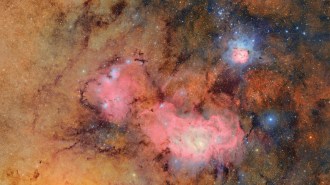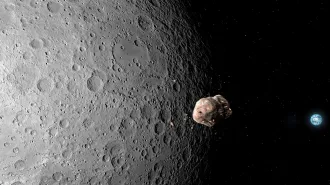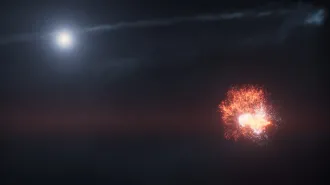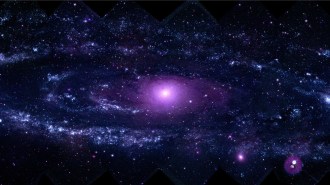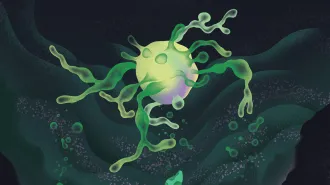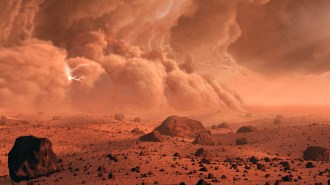Black holes are encircled by thin rings of light. This physicist wants to see one
An image of a ‘photon ring’ could test Einstein’s general theory of relativity

A mysterious ring of light is thought to surround every black hole, and Alex Lupsasca wants to glimpse one for the first time. The tendril-thin halo, called a photon ring, has the power to reveal secrets from the black hole’s edge.
Black holes are regions of the universe where spacetime is warped so dramatically that nothing can escape. Physicists predict that particles of light, or photons, can graze the edge of the black hole without falling in. These photons orbit the black hole one or more times before breaking away. This light makes up the photon ring.
Spotting the photon ring could help test physicists’ theories about these mysterious objects, and whether any alternative explanations could account for them. “Seeing this photon ring and confirming that it’s really produced by orbiting photons would be ironclad, definitive proof that the object that we’re looking at really is a black hole,” Lupsasca says.
Lupsasca, a theoretical physicist at Vanderbilt University in Nashville, is the project scientist for the Black Hole Explorer. His work has illuminated the potential properties of the photon ring the researchers aim to detect. The project’s goal is to put a space-based radio telescope in Earth orbit in 2031. By joining forces with other radio telescopes on the ground, it would effectively create a telescope three times the size of Earth. That would allow scientists to take the sharpest images in the history of astronomy, Lupsasca says, and hopefully reveal the photon ring.
This summer, the capabilities of AI startled Lupsasca. When he prodded the large language model GPT-5 Pro, it reproduced the conclusion of one of his papers, deducing in minutes what he’d spent weeks pondering. In October, he also joined OpenAI for Science, where he’ll continue researching black holes.
For Lupsasca, the search for the photon ring is paramount. “What higher calling could you find than to try to understand the mysteries of the universe?”
TRANSCRIPT
Alex Lupsasca: Black holes are the most extreme objects in the universe. And I think what’s really exciting is that we live in a very, very special time in the history of physics, and black hole physics in particular, where we’re finally able now to interact with these objects.
Only in the late ’80s, I think, indirect evidence for the presence of black holes in certain galaxies finally changed most people’s minds, but we still didn’t have direct contact with black holes until the last decade. First with LIGO, the Laser Interferometer for Gravitational-Wave Observatory that discovered the first gravitational waves produced by two black holes merging. So that was a direct probe, through gravity, of real black holes in the sky. Really amazing moment. And then very soon after, in 2019, the Event Horizon Telescope released the first image of the black hole.
So now we can hear them through gravitational waves and we can even see them. And that’s absolutely a remarkable shift because this purely theoretical subject, which used to be even quite esoteric and people even think black holes weren’t a thing for a long time, now is an experimental science. And it’s an experimental science that is at the observational frontier in astronomy. And I think we’re going to learn so much about all these different phenomena that have really been mysterious for so long. And that’s a really exciting time to be working in this field.
The Black Hole Explorer is this really exciting, proposed space mission to launch a satellite into Earth orbit that will take the sharpest images in the history of astronomy and allow us to make high-resolution movies of black holes. And one of the main targets of this experiment is this so-called photon ring, which is a very thin, narrow ring of light that is predicted by Einstein’s theory of general relativity to encircle this dark patch in a black hole image that is produced by the event horizon.
So, our theoretical predictions coming, again, from our best theory to date, which is Einstein’s theory of general relativity, predicts that when you look at an image of a black hole, you should roughly see two main features. One is a dark patch, which is often called the black hole shadow that’s cast by the black hole because the event horizon absorbs light. Around this dark patch, you should see a very thin ring of light that we call the photon ring. And this ring of light is produced by photons, particles of light, that orbit around the black hole, possibly multiple times on their way from their source, which is some hot matter around the black hole, to the observer, which is our telescope. Only a black hole can bend light so much that it actually orbits around it.
So this phenomenon that black holes can capture light and deflect their orbits so much that they get stuck in orbit around the black hole. And seeing this photon ring and confirming that it’s really produced by orbiting photons would be ironclad, definitive proof that the object that we’re looking at really is a black hole. So you should think of this photon ring as being made up of light that skirts the surface, never quite falling in because then it wouldn’t be able to escape, but spending quite a lot of time there probing the geometry of spacetime before escaping and reaching our telescopes to trace out this very special curve that encodes information about the geometry around the black hole. So we’d be literally tracing an edge of the visible universe. So I mean, I think that’s just inherently really, really cool.
One of the things I’m most excited about in the future of black hole astrophysics is that I think in the next decades, certainly, I hope, within my lifetime, we’ll get to understand in detail how black holes produce energy and act as these most powerful energy engines in the universe. And today we have a few proposed mechanisms for how we think this might work in detail. And I think by peering closer to black holes using many experiments, including the Black Hole Explorer, we’ll be able to not just make images but even movies of the black hole as it rotates and the matter around it swirls around. And I think, gathering evidence to test this hypothesis is absolutely paramount. I think an affirmative answer that confirms that this is the mechanism would finally tell us what powers the brightest lights in the universe. I’d like to know what it is. I think it’s super, super cool. What higher calling could you find than to try to understand the mysteries of the universe?

